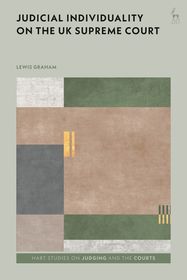
Judicial Individuality on the UK Supreme Court
Series: Hart Studies on Judging and the Courts;
- Publisher's listprice GBP 85.00
-
40 608 Ft (38 675 Ft + 5% VAT)
The price is estimated because at the time of ordering we do not know what conversion rates will apply to HUF / product currency when the book arrives. In case HUF is weaker, the price increases slightly, in case HUF is stronger, the price goes lower slightly.
- Discount 13% (cc. 5 279 Ft off)
- Discounted price 35 330 Ft (33 647 Ft + 5% VAT)
Subcribe now and take benefit of a favourable price.
Subscribe
40 608 Ft

Availability
printed on demand
Why don't you give exact delivery time?
Delivery time is estimated on our previous experiences. We give estimations only, because we order from outside Hungary, and the delivery time mainly depends on how quickly the publisher supplies the book. Faster or slower deliveries both happen, but we do our best to supply as quickly as possible.
Product details:
- Publisher Bloomsbury Publishing (UK)
- Date of Publication 6 February 2025
- Number of Volumes Hardback
- ISBN 9781509971107
- Binding Hardback
- No. of pages304 pages
- Size 236x152x20 mm
- Weight 601 g
- Language English 735
Categories
Long description:
This book presents an empirical analysis of the UK Supreme Court's output over its first ten years, with a specific focus on each individual judge's contribution to each case. It shows that judges, like all of us, are human; it would be difficult to imagine that any of us, even in our most professional capacity, could act completely independently of our predilections, motivations and biases. The same is true for the judges sitting on the UK's highest court.
Drawing on insights from a bespoke dataset of judgments, this work discerns trends and tendencies across each judge's voting patterns and the reasoning they adopt when disposing of cases. It not only highlights areas of divergence, but also shows how each of the judges tended to vote in different contexts, including which were more likely to overturn appeals from lower courts, side with certain parties such as the state or underdogs, and find liability in various areas (tort, contract, criminal, EU, immigration and tax law, with a special focus on human rights cases). Another section illustrates the differences between the judges when it comes to judicial reasoning, such as their approach to precedent and preferred methods of statutory interpretation.
This work shows that different judges exercise their power in different ways. Some are more comfortable with pushing boundaries whilst others are more restrained. Some grant the state a lot of leeway whilst others apply heavy scrutiny. Some are, as Lord Denning suggested, 'bold spirits' whilst others are 'timorous souls'. It shows, at least when it comes to the Supreme Court, that it matters who our judges are.
Table of Contents:
1. Introduction: The Court and its Judges
2. Measuring Judicial Behaviour
3. The Nature of Individual Judicial Contributions
4. Appeals from Lower Courts
5. Party Sympathy
6. Legal Subject-Areas
7. Human Rights
8. Legal Tools and Cross-Cutting Questions: Statutes, Precedent, Jurisdiction and Remedies
9. Politics and Personalities
10. The Supreme Court Since 2020: A More Conservative Court?
11. Implications and Conclusions




